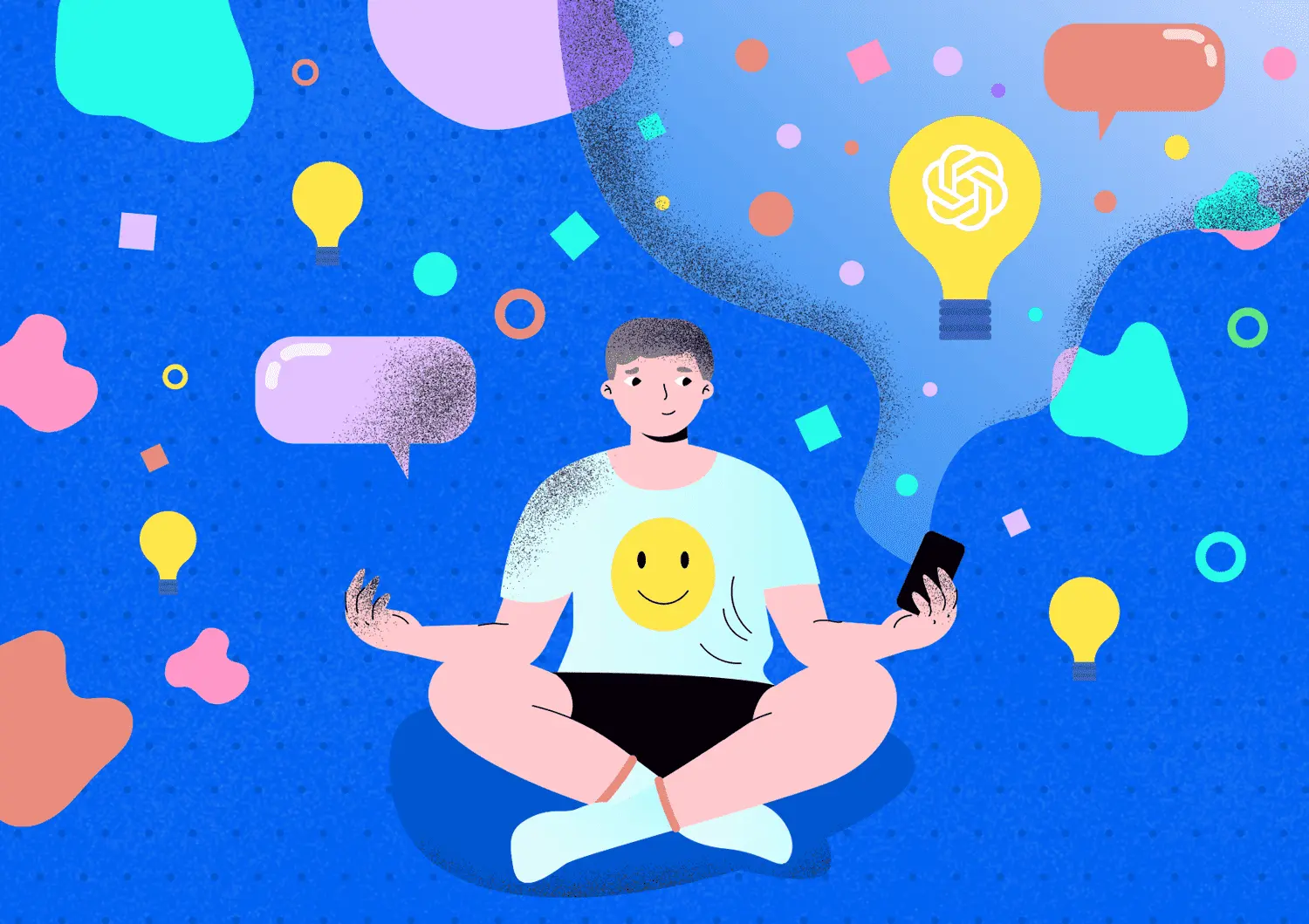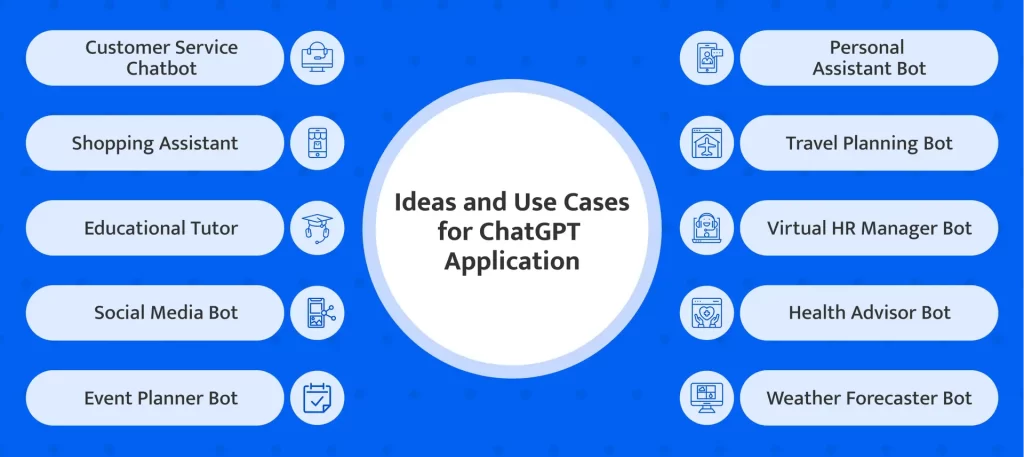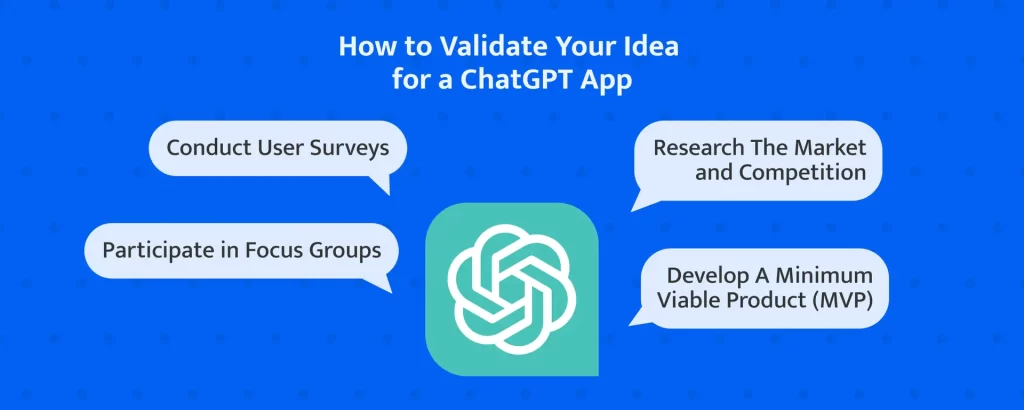Creating Next-Generation AI Apps: Innovate with ChatGPT

Chatbots have revolutionized how businesses interact with customers by providing quick and efficient communication channels. With the advancements in AI, chatbots have become even more sophisticated, handling complex queries and providing personalized experiences. One such AI-powered tool is ChatGPT, an advanced chatbot platform that uses the latest language models to understand and respond to user requests.
This article will explore the various ChatGPT-powered app ideas or how this technology can be integrated into the existing product. From customer service chatbots to language learning apps, chatGPT offers a range of possibilities to engage users and enhance their overall experience. So, if you want to learn more about ChatGPT ideas for business, please keep reading!
Table of contents
- How to Brainstorm the Ideas of Apps Built With ChatGPT
- ChatGPT Application Ideas and Use Cases
- ChatGPT App Examples Already Existing
- How to Validate Your ChatGPT App Idea
- How Alternative-spaces Can Help You Integrate ChatGPT
- Wrapping up
- FAQ
How to Brainstorm the Ideas of Apps Built With ChatGPT

When brainstorming ChatGPT application ideas, the possibilities are endless. Here are some tips to help you get started:
- Identify a problem: Identify a common problem people face, and use ChatGPT to provide a solution. For instance, if people struggle with managing their time, you could create a personal assistant app that uses ChatGPT to keep track of their schedule.
- Look at current trends: Stay up-to-date with current trends and use ChatGPT to accelerate them. Research topics people are interested in and create a chatbot built around that topic. For example, there is a rising interest in mental health, so creating a mental health chatbot could be perfect.
- Explore different industries: Think outside the box and look for opportunities to apply ChatGPT in different industries. For instance, you could build a ChatGPT model for real estate agents that uses this technology to schedule appointments, respond to inquiries, and provide property recommendations.
- Personalize user experiences: Use ChatGPT to create a customized user experience that adapts to the user’s preferences. For instance, you could build a chatbot that learns about the user’s taste in music and recommends new artists or songs based on their listening history.
- Conduct user research: To understand what users need or want from a chatbot. This can help you identify pain points and find ways to solve them.
ChatGPT Application Ideas and Use Cases

With chatGPT, you can build a wide range of chat applications that use the power of AI to engage users and respond to their requests. Here are a few examples:
Customer Service Chatbot
A customer service chatbot built with chatGPT can help customers find answers to their questions and even provide personalized advice based on their needs. For example, a customer service bot could be programmed to answer basic inquiries such as information about a product, hours of operation, and more.
Shopping Assistant
With chatGPT, a shopping assistant chatbot can be created to assist users with finding the best deals for products and services. The bot could provide price comparisons between stores, search for coupons or promotional codes, and suggest other related items that may not appear in the user’s initial search query.
Educational Tutor
A tutoring bot built with chatGPT can aid students in learning by providing explanations of concepts in an interactive manner through conversations and quizzes. The bot could be programmed with subject-specific material like vocabulary lists or equations in mathematics and sciences. Additionally, the bot can also provide feedback regarding a student’s progress by tracking their responses to questions or tasks over time.
Social Media Bot
With chatGPT, creating a social media bot that can respond to users’ posts or messages on various platforms like Facebook, Twitter, and Instagram automatically or semi-automatically based on user input is possible. The bot could respond with pre-programmed phrases such as “Thanks for your post!” or “We appreciate your feedback!”
Event Planner Bot
An event planning bot built with chatGPT can help plan parties, conferences or other events by automating tasks like creating invitations and sending out reminders about upcoming meetings/events via text message or email to participants who have given permission to do so beforehand. The bot could also provide helpful tips related to the event, such as suggesting caterers or venues that would fit within budget constraints set by the user/organizer.
Personal Assistant Bot
A personal assistant chatbot powered by chatGPT can help manage daily routines like setting calendar appointments, checking emails, scheduling meetings, etc., while also taking care of mundane tasks such as grocery shopping online when provided with the necessary input data from the user (i.e., what type of groceries they need).
Travel Planning Bot
A travel planning chatbot built using chatGPT would allow users to easily book flights, hotels, and car rides at their convenience without needing any human interaction involved in the process apart from providing inputs about desired location/destination and travel dates/timeframes, etc., which are then handled automatically by the AI-powered travel planner tool developed via GPT technology.
Virtual HR Manager Bot
Organizations looking for an automated HR solution that works 24 hours a day 7 days a week can benefit from having an AI-powered virtual HR manager built using GPT technology that takes care of employee-related queries such as information regarding benefits packages offered by employers etc., while simultaneously handling employee recruitment processes as well as onboarding new hires into an organization quickly and efficiently without any human labor required to complete these tasks successfully.
Health Advisor Bot
With ChatGpt, it is possible to create an AI health advisor that will ask users questions concerning their health habits, such as exercise frequency, diet preferences, etc., before giving personalized advice tailored towards each individual’s needs based on this information gathered during conversations with them – this advice could range from simple tips on how one should adjust his/her lifestyle choices in order lead a healthier life all the way up till recommending medical remedies if necessary depending upon the severity of one’s condition. Read also about other technology trends in the healthcare industry.
Weather Forecaster Bot
Weather forecasting bots powered by Chatgpt could help users plan their days better depending upon expected weather conditions – these bots might be equipped with features such as hourly forecasts along with temperature readings taken from multiple meteorological sources around the world, which then helps give accurate predictions free from bias errors due the presence of multiple data points being processed simultaneously.
These are just a few examples of how to build an app with ChatGPT. With its powerful AI capabilities, the possibilities are endless!
ChatGPT App Examples Already Existing

Some famous examples of apps that have been built with ChatGPT include:
Jibbigo
Jibbigo is an AI-powered language translation app that uses ChatGPT’s natural language processing technology to deliver real-time, accurate translations between more than 60 languages. It provides users with near-instantaneous translations, allowing them to communicate in different languages without special software or hardware.
Chatterbox
Chatterbox is a virtual assistant app designed to help people efficiently manage their everyday tasks. The app uses ChatGPT’s artificial intelligence technology to understand user requests and answer questions in natural language. It can also alert users in case of emergency situations, provide reminders and helpful tips, and even generate reports on user trends and analytics.
AI Coach
AI Coach is an AI-powered chatbot application that helps athletes improve their performance through personalized coaching advice tailored to their needs and goals. AI Coach utilizes ChatGPT’s machine learning capabilities to learn from the athlete’s data set, providing feedback on how they can optimize their performance and reach their desired outcomes faster.
Neuromate
Neuromate is an intelligent healthcare assistant service that enables doctors to diagnose and treat medical conditions more efficiently through automated conversations with patients using ChatGPT’s natural language understanding capabilities. Neuromate can answer questions about symptoms, provide personalized treatment plans, track patient progress over time, and suggest relevant treatments based on the data collected from previous conversations with users.
Replika
Replika is an AI chatbot designed to help users improve their mental health and well-being. ChatGPT powers the chatbot’s natural language processing and conversational capabilities.
Dialpad
Dialpad is a cloud-based business communication platform with an AI-powered virtual assistant for voice and chat interactions. ChatGPT powers the virtual assistant’s natural language processing and conversational capabilities.
OpenAI API Playground
The OpenAI API Playground is a web-based interface that allows developers to test and experiment with various AI models, including ChatGPT. Users can input text and receive responses generated by ChatGPT and other AI models.
Hugging Face
Hugging Face is an AI company that offers various NLP tools and models, including ChatGPT. Developers can use the ChatGPT model through the Hugging Face API to build conversational AI applications.
How to Validate Your ChatGPT App Idea

Here are 4 ways to validate your ChatGPT app idea:
- Conduct User Surveys: Reach out to potential users and ask for their feedback on your app idea. Surveying users will help you identify their problems and whether your app can solve them.
- Participate in Focus Groups: Conduct focus group sessions to get more detailed feedback and suggestions from potential users. Listen carefully to their feedback and ask questions to understand better what features or solutions they are looking for in a chatbot app.
- Research The Market and Competition: Analyze the current market and competitive landscape to identify what similar chatbot apps already exist and how popular they are with users. This can help you identify potential gaps in the market and differentiate your app from others in the same space.
- Develop A Minimum Viable Product (MVP): An MVP is a basic version of your app that helps you test your idea and gather user feedback without investing much time and money. Launching an MVP can help you get early user feedback and validate your app’s concept, functionality, and market potential. Once you have established demand for your chatbot app, consider investing in its further development.
How Alternative-spaces Can Help You Integrate ChatGPT
Alternative-spaces is a cutting-edge software development company specializing in creating custom solutions for businesses looking to improve their operations. One of the areas Alternative-spaces is highly skilled in is integrating advanced AI tech into existing products, including chatbots like chatGPT.
If you want to integrate chatGPT into your product, Alternative-spaces can help you every step of the way. Here’s how:
- Assessment of Your Needs: Alternative-spaces’s team of experts will assess your needs and help you determine the best way to integrate chatGPT into your product. They will work with you to identify the essential functionalities you need and any constraints or limitations that may impact the implementation.
- Customization of chatGPT: Alternative-spaces will customize chatGPT to suit your specific requirements. This includes tuning the AI models, developing chat flows and conversation scripts, and designing the user interface to fit your branding guidelines.
- Integration with Your Product: Alternative-spaces’s team will then integrate chatGPT into your product, ensuring it aligns with its overall user experience and functionality. Alternative-spaces can integrate chatGPT with various channels, including website chatbots, mobile apps, voice assistants, and more.
- Testing and Quality Assurance: Before deploying chatGPT, Alternative-spaces’s team will conduct comprehensive testing to ensure that it performs flawlessly in your product. They will also provide you with the necessary tools to monitor performance and troubleshoot any technical issues that may arise.
- Ongoing Support and Maintenance: Alternative-spaces provides ongoing support and maintenance to ensure that chatGPT functions seamlessly within your product landscape. They will keep chatGPT updated and maintained so the product remains reliable.
In summary, Alternative-spaces is the ideal partner to help integrate chatGPT into your product. With years of experience in AI integration, Alternative-spaces can deliver a customized solution that exceeds your expectations.
Wrapping up
As we’ve explored in this article, ChatGPT, a state-of-the-art AI language model, can help developers build powerful applications across various industries. From customer service chatbots to personalized recommendation engines, ChatGPT can assist in automating digital interactions, reducing workload, and improving overall user experience.
As natural language processing (NLP) and AI continue to evolve, the potential use cases for ChatGPT and similar models are only limited by our imagination. Developers are empowered to create unique conversational applications to meet the specific needs of their customers, while businesses can benefit from the enormous potential of AI technology to streamline operations and generate new sources of revenue.
It’s clear that chatbots and conversational AI are the future of customer engagement and interaction, and ChatGPT is at the forefront of this exciting revolution. By leveraging the capabilities of this technology and pushing the boundaries of innovation, we can look forward to incredible advances in automation, personalized Artificial Intelligence, and applications that change how we approach digital communication forever.
FAQ
- How to find ChatGPT-based app ideas?
Identify a problem that can be solved through conversational AI, explore existing apps that use ChatGPT, and look for industries that could benefit from conversational AI.
- What kind of apps can be built using ChatGPT technology?
ChatGPT technology can be used to build conversational AI applications such as chatbots, virtual assistants, language translation apps, writing assistants, mental health support chatbots, customer support bots, and more.
- What are some options for deploying my ChatGPT-based app?
There are various options for deploying ChatGPT-based apps, such as cloud platforms like AWS or Google Cloud, deployment platforms like Heroku or Docker, or serverless platforms like Azure Functions or AWS Lambda. Some AI companies like Hugging Face or OpenAI offer API and cloud-based deployment options for their language models, including ChatGPT.
- How can I measure the performance of my ChatGPT-based application?
You can measure the performance of your ChatGPT-based application by evaluating metrics such as accuracy, response time, and user satisfaction. Accuracy can be measured by comparing the generated responses to the expected responses, response time can be measured by tracking the time it takes for the system to generate a response, and user satisfaction can be measured through surveys or feedback mechanisms built into the application. Additionally, you can use tools like conversational analytics and natural language processing tools to gather insights into user behavior and improve the performance of your ChatGPT-based application.
Content created by our partner, Onix-systems.
 Home
Home